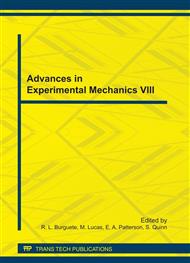p.381
p.387
p.393
p.399
p.405
p.410
p.416
p.422
p.428
Dynamic Response of Thermally Bonded Bicomponent Fibre Nonwovens
Abstract:
Having a unique microstructure, nonwoven fabrics possess distinct mechanical properties, dissimilar to those of woven fabrics and composites. This paper aims to introduce a methodology for simulating a dynamic response of core/sheath-type thermally bonded bicomponent fibre nonwovens. The simulated nonwoven fabric is treated as an assembly of two regions with distinct mechanical properties. One region - the fibre matrix – is composed of non-uniformly oriented core/sheath fibres acting as link between bond points. Non-uniform orientation of individual fibres is introduced into the model in terms of the orientation distribution function in order to calculate the structure’s anisotropy. Another region – bond points – is treated in simulations as a deformable bicomponent composite material, composed of the sheath material as its matrix and the core material as reinforcing fibres with random orientations. Time-dependent anisotropic mechanical properties of these regions are assessed based on fibre characteristics and manufacturing parameters such as the planar density, core/sheath ratio, fibre diameter etc. Having distinct anisotropic mechanical properties for two regions, dynamic response of the fabric is modelled in the finite element software with shell elements with thicknesses identical to those of the bond points and fibre matrix.
Info:
Periodical:
Pages:
405-409
Citation:
Online since:
August 2011
Price:
Сopyright:
© 2011 Trans Tech Publications Ltd. All Rights Reserved
Share:
Citation:


